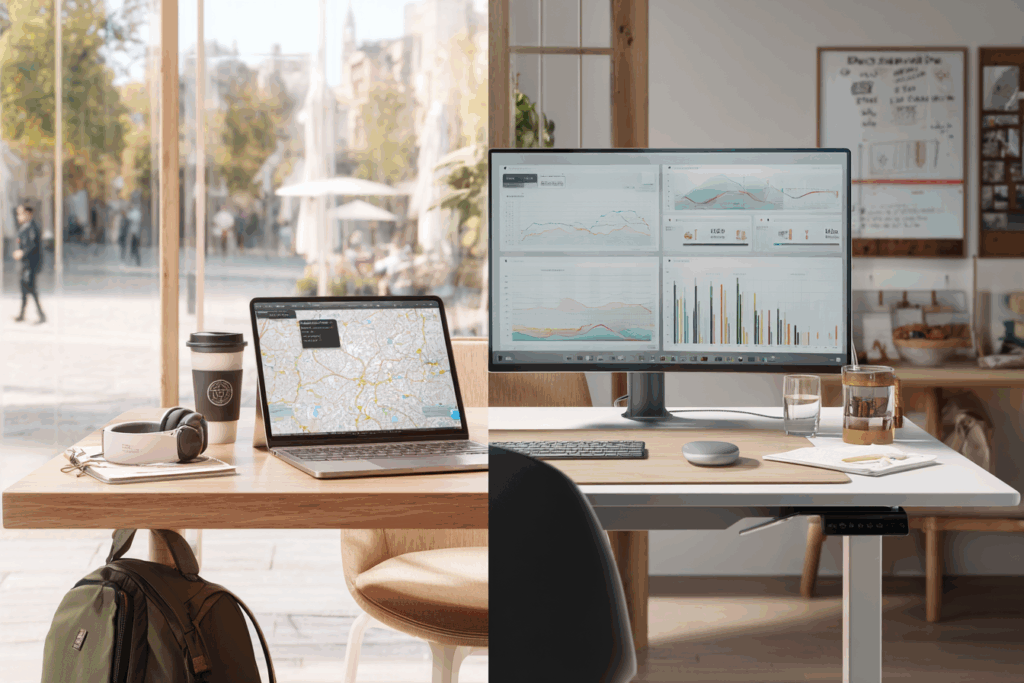The Remote Talent Spectrum: One Size Doesn’t Fit All
The rise of remote work has unlocked access to a global pool of professionals. But as more businesses embrace distributed teams, it’s important to recognize that not all remote talent is the same.
Two types of professionals dominate the remote landscape today: Digital Nomads and Full-Time Remote Workers.
While both operate remotely, their lifestyles, commitments, and work habits can differ significantly. So, how do you know which type of remote talent is right for your business?
In this guide, we break down the key differences between digital nomads and full-time remote workers, their pros and cons, and how to choose the best fit for your company’s needs.
Understanding the Two Types of Remote Talent
Who Are Digital Nomads?
Digital nomads are remote professionals who travel frequently while working. They prioritize location independence and often change countries or cities every few weeks or months.
Typical roles: Freelancers, marketers, writers, developers, consultants.
Common characteristics:
- Highly independent
- Flexible with schedules
- Tech-savvy and adaptable
- Motivated by lifestyle freedom
Who Are Full-Time Remote Workers?
These professionals are hired as employees or long-term contractors. While they work from home (or co-working spaces), they usually remain in one geographic location for extended periods.
Typical roles: Virtual assistants, recruiters, designers, project managers, sales reps, customer support.
Common characteristics:
- Structured routines
- Long-term employment mindset
- Strong integration with internal teams
- More stability and continuity
Comparing Digital Nomads and Full-Time Remote Workers
| Feature | Digital Nomads | Full-Time Remote Workers |
|---|---|---|
| Work Setup | Freelance or project-based | Employee or long-term contractor |
| Location | Frequently changes | Usually fixed |
| Commitment | Short to mid-term | Long-term |
| Availability | May vary by time zone or travel | Predictable and consistent |
| Integration | More independent | Better suited for team integration |
| Stability | Less predictable | High stability |
| Best for | Project-based work, creative gigs | Ongoing roles, structured workflows |
Pros and Cons of Each Remote Talent Type
Digital Nomads: Pros
- Fast execution for short-term or project work
- Culturally diverse insights and global perspective
- Often cost-efficient on a per-project basis
Digital Nomads: Cons
- Risk of inconsistent internet or availability
- Harder to manage in structured environments
- Less invested in long-term company goals
Full-Time Remote Workers: Pros
- Deep company knowledge over time
- Easier to build into teams and processes
- Reliable availability and performance tracking
Full-Time Remote Workers: Cons
- May require longer onboarding
- Less flexibility for short-term needs
- Slightly higher overhead (benefits, training, etc.)
Choosing the Right Remote Talent for Your Business
1. Define the Nature of the Role
- Is it project-based or ongoing?
- Does it require cross-functional collaboration?
- Is long-term consistency important?
If you’re looking to scale a core department (e.g., operations, recruitment, customer support), full-time remote workers are ideal.
If you’re experimenting with a short-term campaign or testing new ideas (e.g., marketing assets, sales pages, audits), a digital nomad might fit the bill.
2. Consider Communication and Time Zone Needs
- Will the role require daily check-ins or team meetings?
- Do you need coverage in a specific time zone?
Digital nomads often roam across time zones, which could affect coordination. Full-time remote workers generally offer more stable schedules.
3. Evaluate Integration vs Independence
If the role demands alignment with your company’s internal systems, shared knowledge bases, and team collaboration tools, full-time remote talent is a better fit.
For roles that require autonomy and short bursts of creative output, digital nomads can offer speed and flexibility.

EA Recruitment Group’s Expertise in Sourcing the Right Remote Talent
At EA Recruitment Group, we specialize in helping businesses build high-performance teams using remote talent that aligns with their culture, systems, and goals.
We:
- Vet and source elite full-time remote professionals (especially from the Philippines)
- Provide contract structure guidance for both long-term and short-term roles
- Help assess role suitability for remote work types
Whether you’re building your core team or need project-based support, we help you make the right remote hiring decisions with confidence.
FAQs: Digital Nomads vs Full-Time Remote Talent
1. Are digital nomads less reliable than full-time remote workers?
Not necessarily, but they may have more schedule fluctuations due to travel. For critical roles, stability may be a concern.
2. Can I hire a digital nomad full-time?
Yes, but only if their lifestyle aligns with your expectations around time zones, availability, and deliverables.
3. What tools help manage different remote talent types?
Tools like Slack, Asana, Notion, and Hubstaff help streamline collaboration with both types of remote professionals.
4. Is it cheaper to hire digital nomads?
Often, yes—for project-based work. But for long-term roles, full-time remote workers may deliver more value over time.
5. How does EA Recruitment Group support remote hiring?
We assess your needs, match you with qualified remote talent, and help ensure the right level of integration, culture fit, and performance alignment.
One Goal, Two Paths
Both digital nomads and full-time remote workers represent the evolution of the modern workforce. But they serve different purposes.
Choosing the right remote talent depends on your:
- Role expectations
- Team structure
- Timeframe and goals
Smart businesses know when to use each—and how to blend both for maximum impact.
Ready to Hire Remote Talent That Fits Your Business Model?
EA Recruitment Group helps you tap into global talent—whether you need consistent full-time support or agile project execution.
👉 Book a Free Remote Talent Strategy Call
Or visit our website to learn more about our brands and insights.


Leave a Reply